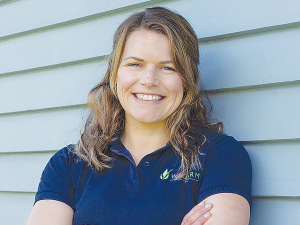Pain relief for lame cows a game changer
The traditional method to approach lameness involves corrective trimming of the affected area.
 WelFarm general manager Samantha Tennent and her team have developed a new website covering the basics of dairy herd health and welfare.
WelFarm general manager Samantha Tennent and her team have developed a new website covering the basics of dairy herd health and welfare.
While advancements in technology has put information at our fingertips, filtering and finding the right information can be challenging.
Samantha Tennent recalls this exact problem when she was studying. That's why Tennent, who's general manager at WelFarm, and her team have developed a new website covering the basics of dairy herd health and welfare.
"I didn't come off a farm and I was trying to get my head around mastitis, but I remember I couldn't even find the basic definition for a somatic cell count which left me feeling stupid," she explains. "Since then, whenever I've been involved with extending messaging, I try to include the basics."
Tennent says the new WelFarm website keeps information brief, to the point and provides links to other web pages for further information.
"We didn't want to recreate what is already available; there are some great sources of information but sometimes they get lost in the seas," she adds. "We were keen to consolidate and provide a simple hub for herd health and welfare to help farmers find what they need."
Tennent says this will continue to evolve, and they plan to use the website to share timely information to help farmers with their seasonal herd planning.
"Now is a great example, it's the ideal time to be performing a locomotion score on your herd," she explains. "Identify animals that are starting to show signs of lameness, determine if they need treatment and get on top of it before they impact of the business with reduced production and impaired reproductive performance."
The WelFarm team are also building their social media strategy to support farmers with timely messages. This month they are talking about the second half of mating.
"Bringing the whole herd in to apply a fresh heat detection aid can help refresh for tired eyes and bulls need to be rotated 24-48 hourly to allow them time to recharge. We want to give farmers simple, timely reminders to help make things easier."
The WelFarm programme is delivered through vet clinics and provides a framework for farmers and vets to proactively monitor and manage herd health. Benchmarking provides context to the numbers and allows farmers to identify opportunities and prevent problems to save time and effort in the long run.
Taranaki sharemilker Trish Rankin has been using the programme with their local vet team at Taranaki Veterinary Centre. She values the feedback, explaining they either get a 'tick' saysing they're doing a great job or some feedback on what needs to be improved. "Farmer and animal well-being is a key key outcome of WelFarm."
New Zealand needs a new healthcare model to address rising rates of obesity in rural communities, with the current system leaving many patients unable to access effective treatment or long-term support, warn GPs.
Southland farmers are being urged to put safety first, following a spike in tip offs about risky handling of wind-damaged trees
Third-generation Ashburton dairy farmers TJ and Mark Stewart are no strangers to adapting and evolving.
When American retail giant Cosco came to audit Open Country Dairy’s new butter plant at the Waharoa site and give the green light to supply their American stores, they allowed themselves a week for the exercise.
Fonterra chair Peter McBride says the divestment of Mainland Group is their last significant asset sale and signals the end of structural changes.
Thirty years ago, as a young sharemilker, former Waikato farmer Snow Chubb realised he was bucking a trend when he started planting trees to provide shade for his cows, but he knew the animals would appreciate what he was doing.